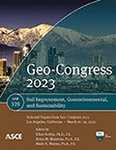Methods for Enhancing Uniformity of Biocementation Treatment in Sand
Publication: Geo-Congress 2023
ABSTRACT
One of the difficulties for the application of microbial induced carbonate precipitation (MICP) or enzyme induced carbonate precipitation (EICP) for soil treatment is to ensure uniformity in the treatment across the whole soil sample or soil profile. Methods that can be adopted to improve the uniformity of MICP or EICP treatment are reviewed and compared. Experimental data are presented to demonstrate that a newly proposed one-phase-low-pH injection method enables better uniformity to be achieved among different methods. Other factors affecting the uniformity of treatment are discussed. Measures to be adopted to enhance the uniformity of MICP or EICP treatment in sand are suggested.
Get full access to this article
View all available purchase options and get full access to this chapter.
REFERENCES
Al, Q. A., Soga, K., and Santamarina, C. (2012). “Factors affecting efficiency of microbially induced calcite precipitation.” Journal of Geotechnical and Geoenvironmental Engineering, 138(8):992–1001.
Almajed, A., Khodadadi, T. H., and Kavazanjian, E., Jr. (2018). “Baseline Investigation on Enzyme-Induced Calcium Carbonate Precipitation.” Journal of Geotechnical and Geoenvironmental Engineering, 144(11), 04018081.
Almajed, A., Khodadadi, T. H., Kavazanjian, E., Jr., and Hamdan, N. (2019). “Enzyme induced biocementated sand with high strength at low carbonate content.” Scientific Reports, 9(1135):1–7.
Arab, M. G., Rohy, H., Zeiada, W., Almajed, A., and Omar, M. (2021). “One-Phase EICP Biotreatment of Sand Exposed to Various Environmental Conditions.” Journal of Materials in Civil Engineering, 33(3), 04020489.
ASTM. ASTM D2166. (2013). Standard test method for unconfined compressive strength of cohesive soil. ASTM International, West Conshohocken.
Cheng, L., Shahin, M. A., and Chu, J. (2019). “Soil bio-cementation using a new one-phase low-pH injection method.” Acta Geotechnica, 14(3), 615–626.
Chu, J., Ivanov, V., Naeimi, M., Stabnikov, V., and Liu, H. L. (2014). “Optimization of calcium-based bioclogging and biocementation of sand.” Acta Geotechnica, 9, 277–285.
Cui, M. J., Lai, H. J., Hoang, T., and Chu, J. (2021). “One-phase-low-pH enzyme induced carbonate precipitation (EICP) method for soil improvement.” Acta Geotechnica, 16, 481–489.
DeJong, J. T., Fritzges, M. B., and Nüsslein, K. (2006). “Microbially induced cementation to control sand response to undrained shear.” Journal of Geotechnical and Geoenvironmental Engineering, 132(11), 1381–1392.
Dupraz, S., Parmentier, M., Ménez, B., and Guyot, F. (2009). “Experimental and numerical modeling of bacterially induced pH increase and calcite precipitation in saline aquifers.” Chemical Geology, 265(1-2), 44–53.
Gao, Y. F., He, J., Tang, X. Y., and Chu, J. (2019). “Calcium carbonate precipitation catalyzed by soybean urease as an improvement method for fine-grained soil.” Soils and Foundations, 59(5), 1631–1637.
Ghosh, T., Bhaduri, S., Montemagno, C., and Kumar, A. (2019). “Sporosarcina pasteurii can form nanoscale calcium carbonate crystals on cell surface.” PloS one, 14(1), e0210339.
He, J., Gao, Y. F., Gu, Z. X., Chu, J., and Wang, L. Y. (2020). “Characterization of crude bacterial urease for CaCO3 precipitation and cementation of silty sand.” Journal of Materials in Civil Engineering, 32(5), 04020071.
Hoang, T., Alleman, J., Cetin, B., and Choi, S. G. (2020). “Engineering properties of biocementation coarse- and fine-grained sand catalyzed by bacterial cells and bacterial enzyme.” Journal of Materials in Civil Engineering, 32(4), 04020030.
Hoang, T., Alleman, J., Cetin, B., Ikuma, K., and Choi, S. G. (2019). “Sand and silty-sand soil stabilization using bacterial enzyme—induced calcite precipitation (BEICP).” Canadian Geotechnical Journal, 56:808–822.
Ismail, M. A., Joer, H. A., Sim, W. H., and Randolph, M. F. (2002). “Effect of cement type on shear behavior of cemented calcareous soil.” Journal of Geotechnical and Geoenvironmental Engineering, 128(6): 520–529.
Ivanov, V., Chu, J., Stabnikov, V., He, J., and Naeimi, M. (2010). “Ironbased bio-grout for soil improvement and land reclamation.” Proc. 2nd Int. Conf. Sustainable Construction Mater. Technol, AnconaSpecial, 415–420.
Lai, H. J., Wu, S. F., Cui, M. J., and Chu, J. (2021). “Recent development in biogeotechnology and its engineering applications. Frontiers of Structural and Civil Engineering, 15(5), 1073–1096.
Kalantary, F., and Kahani, M. (2019). “Optimization of the biological soil improvement procedure.” International Journal of Environmental Science and Technology, 16(8), 4231–4240.
Mitchell, A. C., and Ferris, F. G. (2006). “The influence of Bacillus pasteurii on the nucleation and growth of calcium carbonate.” Geomicrobiology Journal, 23(3-4), 213–226.
Montoya, B. M., DeJong, J. T., and Boulanger, R. W. (2013). “Dynamic response of liquefiable sand improved by microbial-induced calcite precipitation.” Géotechnique, 63, 302–312.
Neupane, D., Yasuhara, H., Kinoshita, N., and Ando, Y. (2015). “Distribution of mineralized carbonate and its quantification method in enzyme mediated calcite precipitation technique.” Soils and Foundations, 55(2):447–457.
Park, S. S., Choi, S. G., and Nam, I. H. (2014). “Effect of plant-induced calcite precipitation on the strength of sand.” Journal of Materials in Civil Engineering, 26(8):06014017.
Whiffin, V. S., van Paassen, L. A., and Harkes, M. P. (2007). “Microbial carbonate precipitation as a soil improvement technique.” Geomicrobiology Journal, 24(5), 417–423.
Xiao, Y., Wang, Y., Desai, C. S., Jiang, X., and Liu, H. (2019). “Strength and deformation responses of biocemented sands using a temperature-controlled method.” International Journal of Geomechanics, 19(11), 04019120.
Yasuhara, H., Neupane, D., Hayashi, K., and Okamura, M. (2012). “Experiments and predictions of physical properties of sand cemented by enzymatically-induced carbonate precipitation.” Soils and Foundations, 52(3):539–549.
Information & Authors
Information
Published In
History
Published online: Mar 23, 2023
Authors
Metrics & Citations
Metrics
Citations
Download citation
If you have the appropriate software installed, you can download article citation data to the citation manager of your choice. Simply select your manager software from the list below and click Download.
